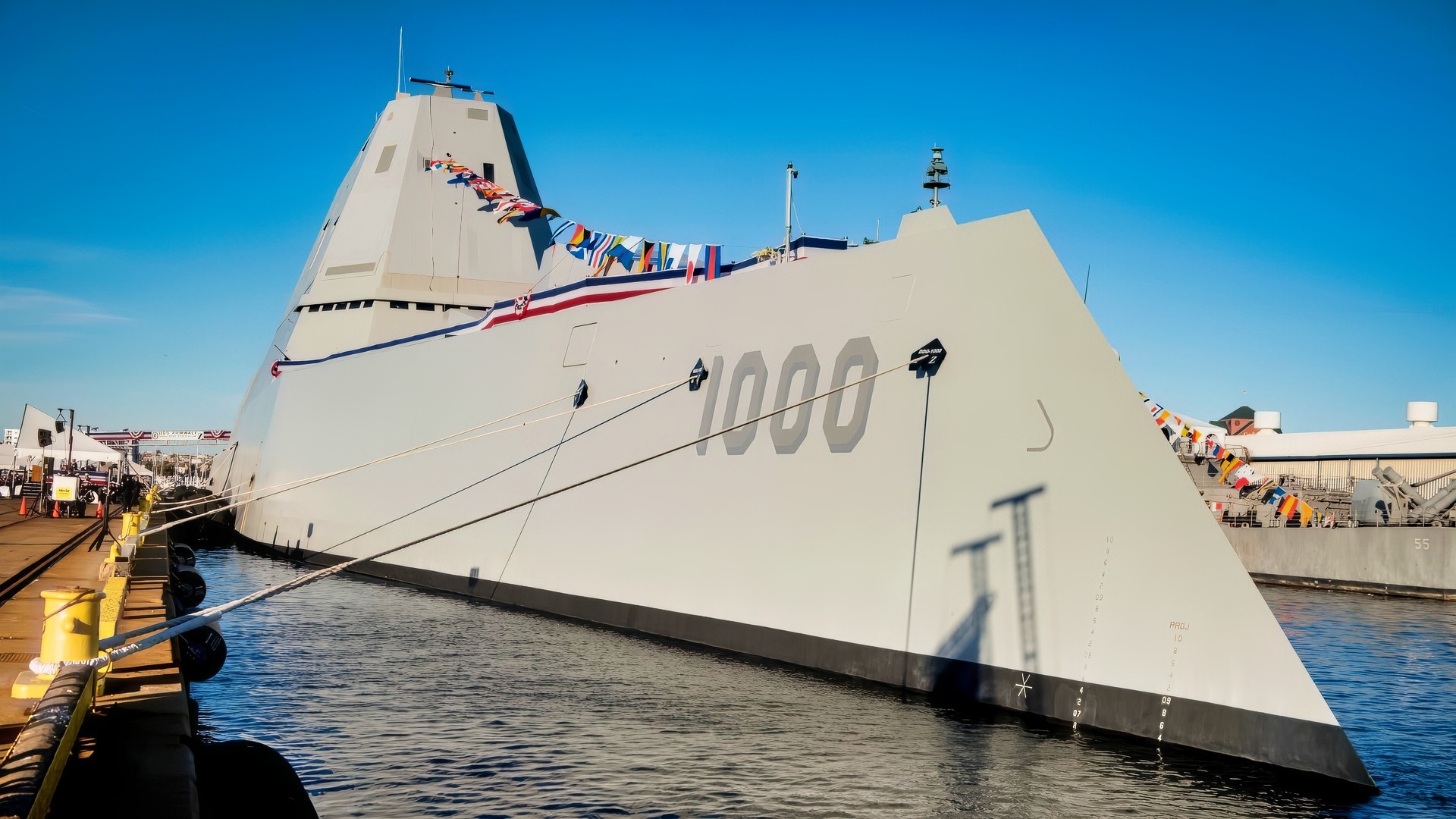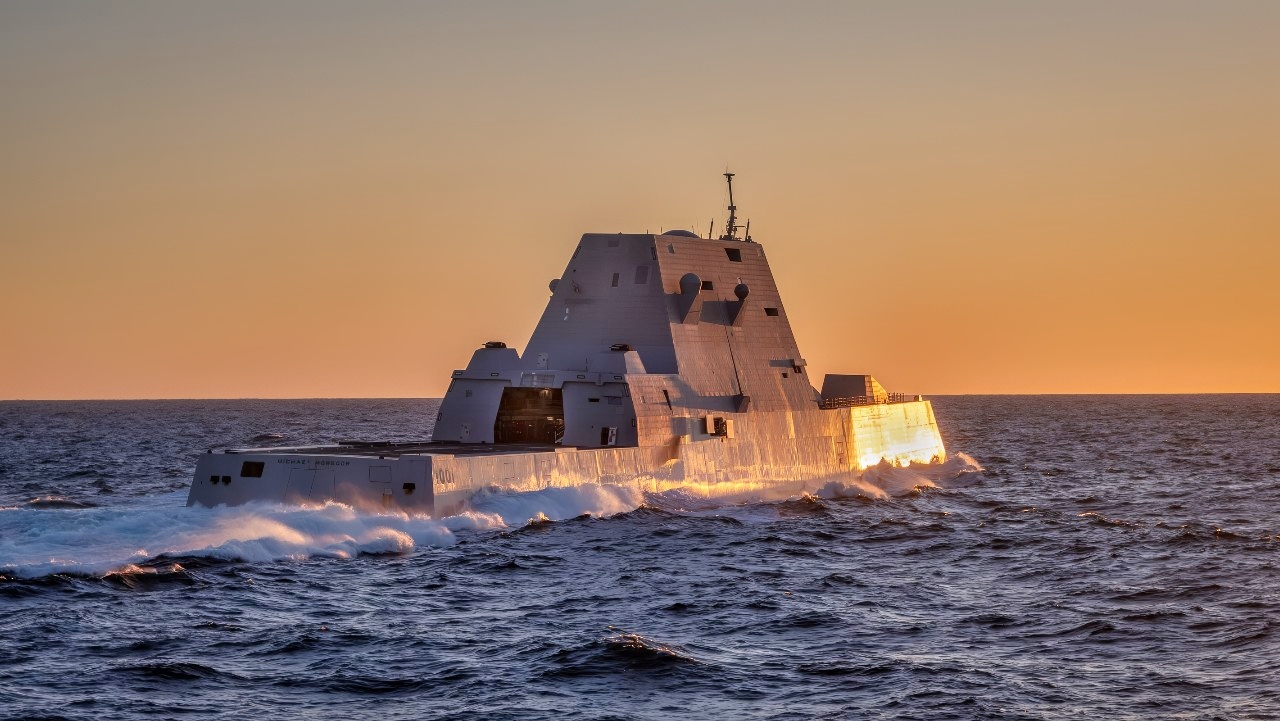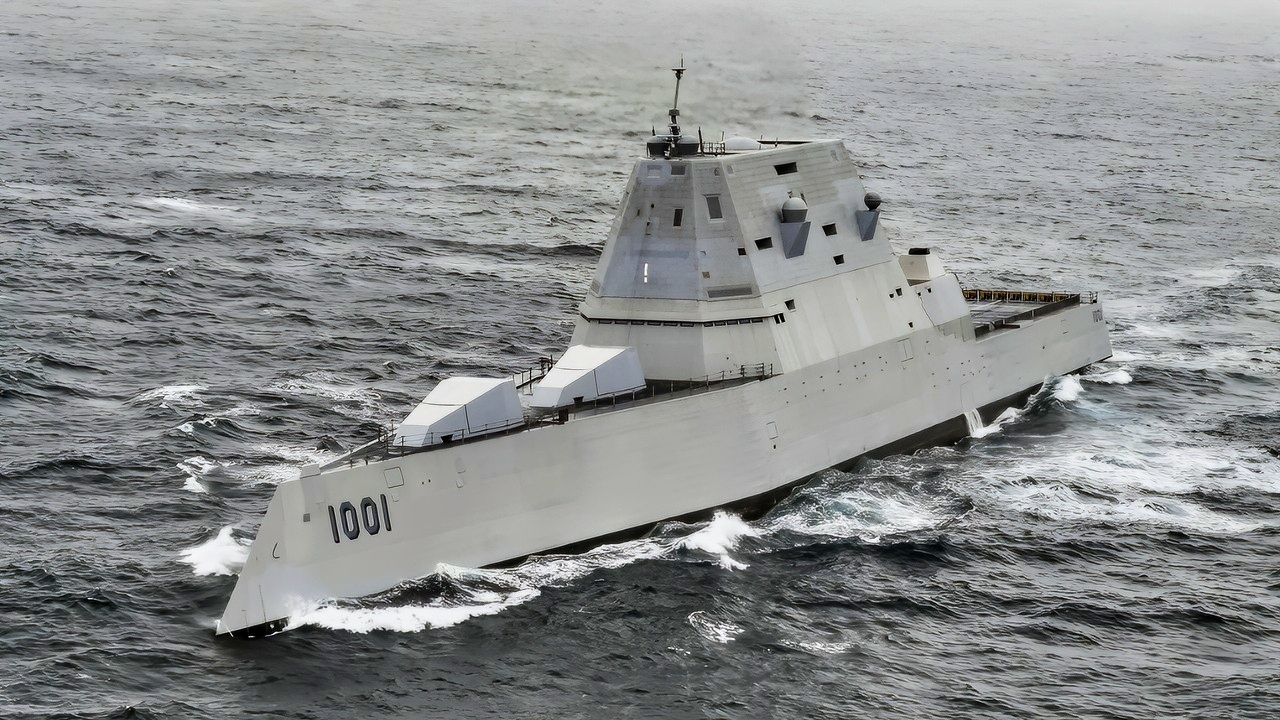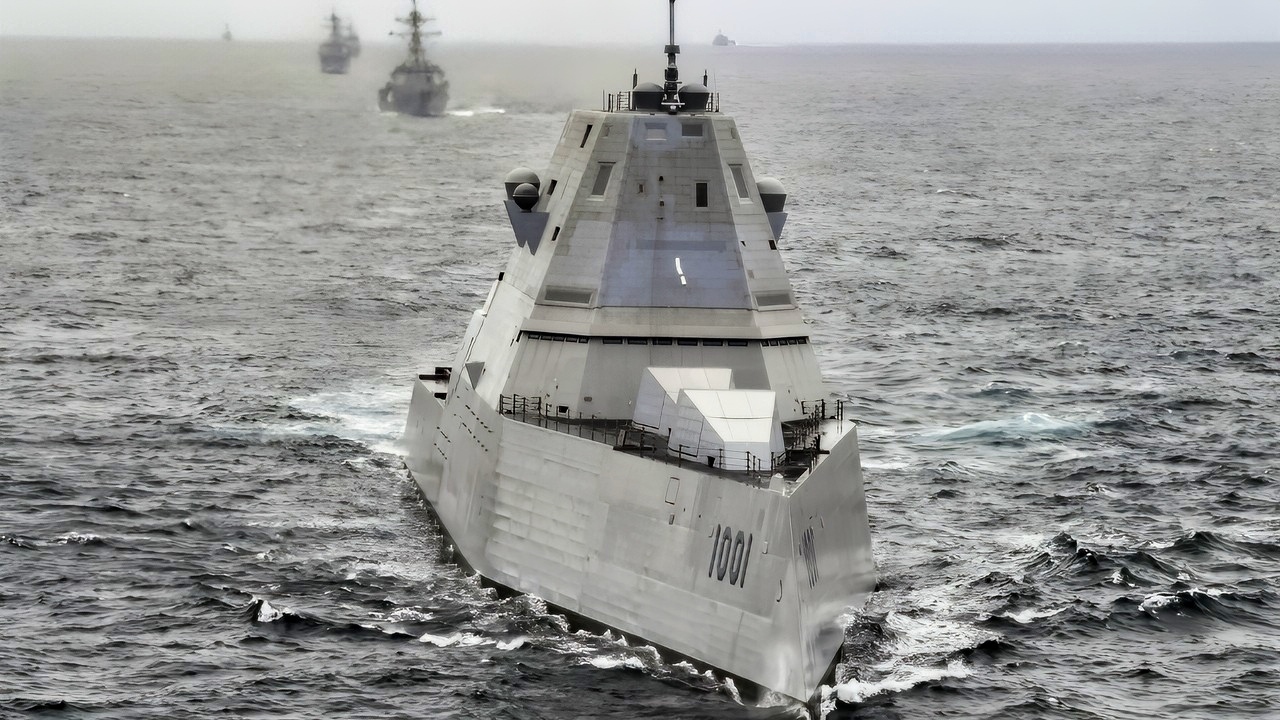Key Points and Summary – The Navy plans to arm all three Zumwalt-class destroyers with Conventional Prompt Strike (CPS) hypersonic glide vehicles, giving the stealthy DDG-1000 hull a long-range, Mach 5+ strike option.
-CPS uses a common glide body (with the Army’s LRHW) boosted to near-space, then maneuvers unpredictably during descent—harder to track and intercept than ballistic arcs and typically longer-ranged than scramjet cruise.

The Navy’s newest and most technologically advanced warship, USS Zumwalt (DDG 1000), is moored to the pier during a commissioning ceremony at North Locust Point in Baltimore. (U.S. Navy photo by Petty Officer 1st Class Nathan Laird/Released)
-Zumwalt’s low radar cross-section enables surprise launch windows, expanding roles beyond land attack.
-In a Western Pacific fight—amid China’s DF-17/YJ-21 advances—sea-based hypersonics raise deterrence, complicate PLA planning, and could evolve toward limited defensive intercept concepts against massed salvos.
The Zumwalt-Class Saved in 1 Word: Hypersonics?
The destroyer USS Zumwalt and her two sister ships have surely had their share of problems. However, they might soon be armed with hypersonic missiles.
Able to strike targets from thousands of miles at five times the speed of sound, this future attack option will likely be able to hold even the most advanced adversaries at risk.
Hypersonic missiles introduce new tactics and concepts of operation for maritime warfare.
Going Long, Striking Fast
The U.S. Navy’s plan to arm its three Zumwalt-class vessels with hypersonic missiles first came to light some years ago. The technology has progressed to the point now that the tactical advantages of the plan have some shape and context.

(February 10, 2024) — The Zumwalt Class Guided Missile Destroyer USS Michael Monsoor (DDG 1001) breaks away from the Henry J. Kaiser-class fleet replenishment oiler USNS Pecos (T-AO 197) shortly before sunset after taking on fuel. (U.S. Navy photo by Chief Mass Communication Specialist Mark D. Faram)
The destroyers will be armed with a hypersonic glide vehicle developed under Conventional Prompt Strike—a program to create a precision missile intended to hold any target in the world at risk of an ultra-long-range, high-speed missile attack. When launched, an aerodynamic projectile will travel up to the boundary of the Earth’s atmosphere with a booster, then enter a glide phase during which the hypersonic projectile uses its speed of descent to glide into and destroy a target.
Stealthy Zumwalt
Years ago, U.S. Naval Sea Systems Command published an essay stating that the stealthy, curved USS Zumwalt appeared as a “small fishing boat” to enemy radar. The hull of the ship is smoothly curved to avoid sharp edges or protruding structures more likely to generate a return signal to enemy radar.
A ship able to launch hypersonic missile attacks while obscured from view presents a significant tactical advantage.
It could introduce an element of surprise to the surface Navy while also improving survivability. The capability could expand the concepts of operation for the Zumwalt-class, a small group of high-tech destroyers initially envisioned for land attack missions.

(April 21, 2021) Zumwalt-class guided-missile destroyer USS Michael Monsoor (DDG 1001) participates in U.S. Pacific Fleet’s Unmanned Systems Integrated Battle Problem (UxS IBP) 21, April 21. UxS IBP 21 integrates manned and unmanned capabilities into challenging operational scenarios to generate warfighting advantages. (U.S. Navy photo by Chief Mass Communication Specialist Shannon Renfroe)
Hypersonic Glide Vehicles
Conventional Prompt Strike has developed in collaboration with the U.S. Army initiative to build the Long Range Hypersonic Weapon – both programs will integrate a common hypersonic glide body.
This common projectile, described as an “all up round,” integrates differently into each weapon to enable a long-range, maneuverable projectile. That maneuverability will make the missile much more difficult to track and intercept than a standard ballistic missile, which follows a predictable parabola-like trajectory.
The pure speed of a hypersonic glide vehicle makes it harder to target as well, given that it transits from one radar’s field of view to another so quickly that radar defense systems are challenged to develop a continuous target track.
Unlike an air-breathing scramjet, which uses sustained rocket propulsion to sustain hypersonic speed, a glide vehicle uses the purse speed of its descent to strike targets.
Typically, hypersonic glide vehicles have a much longer range than scramjets – that and its maneuverability are key reasons the U.S. Navy envisions them as a tool to strengthen the threat of long-range strike and enhance deterrence.

Zumwalt-class Guided Missile Destroyer USS Michael Monsoor (DDG 1001) transits the Pacific Ocean, June 25, 2022. Twenty-six nations, 38 ships, four submarines, more than 170 aircraft and 25,000 personnel are participating in RIMPAC from June 29 to Aug 4 in and around Hawaiian Islands and Southern California. The world’s largest international maritime exercise, RIMPAC provides a unique training opportunity while fostering and sustaining cooperative relationships among participants critical to ensuring the safety of sea lanes and security on the world’s oceans. RIMPAC 2022 is the 28th exercise in the series that began in 1971.

(July 28, 2022) U.S. Navy Zumwalt-class guided-missile destroyer USS Michael Monsoor (DDG 1001) sails in formation during Rim of the Pacific (RIMPAC) 2022, July 28. Twenty-six nations, 38 ships, three submarines, more than 30 unmanned systems, approximately 170 aircraft and 25,000 personnel are participating in RIMPAC from June 29 to Aug. 4 in and around the Hawaiian Islands and Southern California. The world’s largest international maritime exercise, RIMPAC provides a unique training opportunity while fostering and sustaining cooperative relationships among participants critical to ensuring the safety of sea lanes and security on the world’s oceans. RIMPAC 2022 is the 28th exercise in the series that began in 1971. (U.S. Navy photo by Mass Communication Specialist 3rd Class Aleksandr Freutel)
Most of the maneuvering of a glide vehicle is programmed prior to or at launch, and many of them can use GPS or an inertial navigation system for guidance.
Developers of Conventional Prompt Strike and the Long Range Hypersonic Weapon are already anticipating the next generation of hypersonic attacks and are working on software to enable a hypersonic glide vehicle to hit moving targets.
Deter Chinese Hypersonics
The arrival of sea-launched hypersonic weapons is potentially critical to deterrence, given the known progress of the People’s Liberation Army (PLA) in the realm of hypersonics.
The PLA is known to operate the DF-17 hypersonic weapon, and the sea-launched YJ-20 projectile has been tested several times.
Further, the Chinese government–backed Global Times newspaper published an essay last year stating that an H-6 bomber has carried an air-launched YJ-21 variant of this weapon.
During a recent parade, China also showed off several hypersonic weapons that had not been seen publicly before.
China’s YJ-20 was shown, a fact cited in the Global Times, but the display also included the YJ-15, YJ-17, and YJ-19.
The YJ-19 shows an air inlet, which hints at an air-breathing scramjet type of technology, yet much is unknown about the technical specifics of China’s hypersonics arsenal.
Hypersonic Offense and Defense
The arrival of Conventional Prompt Strike on Zumwalt-class destroyers could be especially important in the Western Pacific.
Moving forward, it seems conceivable that ship-launched hypersonic weapons could be used for defensive purposes to help stop, blunt, or slow down an incoming salvo of ballistic and hypersonic weapons.
This is significant, given the concern that China might seek to exploit its current advantage in hypersonic weapons to create a defensive bubble within which opposing forces could not operate.
Such a capability could support a surprise attack on Taiwan, given the PLA’s known arsenal. Should the U.S. Navy develop a comparable hypersonic attack capability, it could very well function as a deterrent.
About the Author: Kris Osborn
Kris Osborn is the President of Warrior Maven – Center for Military Modernization. Osborn previously served at the Pentagon as a highly qualified expert in the Office of the Assistant Secretary of the Army—Acquisition, Logistics & Technology. Osborn has also worked as an anchor and on-air military specialist at national TV networks. He has appeared as a guest military expert on Fox News, MSNBC, The Military Channel, and The History Channel. He also has a Masters Degree in Comparative Literature from Columbia University.
More Military
The F/A-18 Hornet Fighter Has a Message for the U.S. Navy
F-15E Strike Eagle Has Just 1 Mission
Russia’s Su-27 Flanker Fighter: Moscow’s Best Warplane Ever? You Decide
Iowa-Class Battleship USS Wisconsin Has a Message for the U.S. Navy
The U.S. Navy’s USS Connecticut Seawolf-Class Nuclear Attack Submarine Summed Up in 4 Words











Draza Mihajlovic
September 27, 2025 at 4:06 pm
With all the extra power on those ships, they need to put lasers and/or particle beams on them, too.